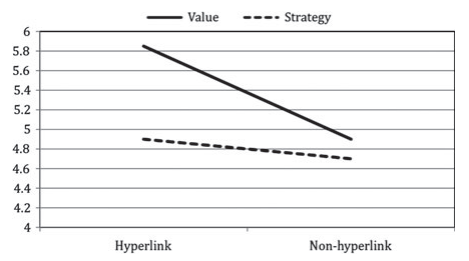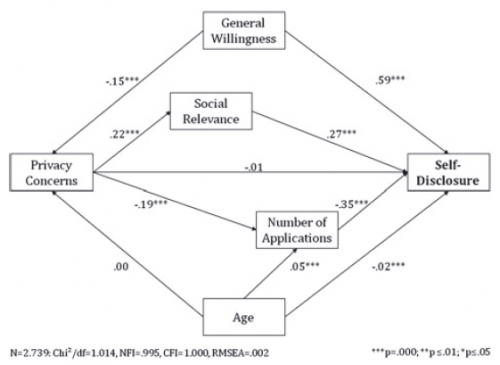![]() In an upcoming issue of the Journal of Computer-Mediated Communication, Borah1 conducted two experiments on 550 people to identify the interactive effect between story framing and embedded links on people reading about politically charged issues – in this case, gay marriage and immigration. The researchers found that a website with critical analysis of political strategy related to gay marriage (or immigration) is viewed as less trustworthy than a website describing the morality of gay marriage (or immigration), even when the factual information reported by those two websites is the same. If you’re running a political website, it seems that emotional appeals about the battle for America’s moral center are more likely to lead to increased readership than thoughtful commentary on political maneuvering. Or in other words, in-depth and critical reporting about politics appears to be the enemy of readership, as sad as that sounds.
In an upcoming issue of the Journal of Computer-Mediated Communication, Borah1 conducted two experiments on 550 people to identify the interactive effect between story framing and embedded links on people reading about politically charged issues – in this case, gay marriage and immigration. The researchers found that a website with critical analysis of political strategy related to gay marriage (or immigration) is viewed as less trustworthy than a website describing the morality of gay marriage (or immigration), even when the factual information reported by those two websites is the same. If you’re running a political website, it seems that emotional appeals about the battle for America’s moral center are more likely to lead to increased readership than thoughtful commentary on political maneuvering. Or in other words, in-depth and critical reporting about politics appears to be the enemy of readership, as sad as that sounds.
When journalists focus their writing upon the morality of political issues (called a “values frame”), readers view the presence of external links as credibility-boosting. When journalists report the same information but focus upon political strategy instead (called a “strategy frame”), readers react cynically and find the article less trustworthy regardless of how many external links are used. The precise nature of this relationship will be clearer with an example:
- Katie the Reporter writes about how gay marriage is saving/destroying America’s soul (values condition). She doesn’t include any links to additional content (no hyperlinks condition). This is the baseline.
- Sue the Reporter writes about how gay marriage is saving/destroying America’s soul (values condition). Throughout her article, she includes links to other articles that support her points (hyperlinks condition). Readers trust Sue’s article more than they trust Katie’s article.
- John the Reporter writes about how various politicians have been using gay marriage to get re-elected or gain political klout (strategy condition). The same factual information about the gay marriage debate is contained in John’s article as is contained in Katie’s and Sue’s articles. Whether John includes links or not, readers trust John’s article less than either Katie’s or Sue’s articles.
The proposed reasons for this effect are fascinating:
- When you read about a moral outrage that you agree with, you are inclined to believe it because it confirms your opinion (this is called confirmation bias). This increases the credibility of the site you’re reading.
- When you read about a moral outrage that you disagree with, you understand the opposition’s viewpoint even if you don’t agree with it. This increases the credibility of the site you’re reading.
- When you read about how politicians are using what you consider to be a moral issue to further their careers, you become cynical about those politicians. By association, you also become cynical about the website you’re reading, which decreases its credibility.
The researcher also found that the mere presence of hyperlinks increases readers’ willingness to seek out more information and actual information-seeking behaviors, although framing did not affect either of these two outcomes.
- Borah, P. (2014). The hyperlinked world: A look at how the interactions of news frames and hyperlinks influence news credibility and willingness to seek information Journal of Computer-Mediated Communication [↩]
![]() In an upcoming issue of the Journal of Computer-Mediated Communication, Taddicken1 explores a phenomenon called the privacy paradox, a term that describes how social media users report that they are concerned about their privacy but do very little to actively protect it. In this study, 2739 German Internet users were surveyed to help identify why people overshare despite such concerns. In her study, roughly 30% of social media users reported sharing personal photos without any access restrictions, and roughly 17% reported sharing their thoughts, experiences, thoughts, feelings, concerns and fears to the wide open Internet.
In an upcoming issue of the Journal of Computer-Mediated Communication, Taddicken1 explores a phenomenon called the privacy paradox, a term that describes how social media users report that they are concerned about their privacy but do very little to actively protect it. In this study, 2739 German Internet users were surveyed to help identify why people overshare despite such concerns. In her study, roughly 30% of social media users reported sharing personal photos without any access restrictions, and roughly 17% reported sharing their thoughts, experiences, thoughts, feelings, concerns and fears to the wide open Internet.
Two personality traits were found to drive sharing: a person’s desire to talk about themselves regardless of situation, followed by the degree to which people found social media to be relevant to their personal social lives. So as it turns out, many people do want it both ways: they want to enrich their social lives by talking about themselves online to anyone who will listen, but they don’t want this information to be read by just anyone. Apparently their desire to be social is simply stronger than their desire to protect their privacy. The important implication here is that it implies simply teaching people about privacy and how to safeguard their information isn’t going to work; the desire to share with others is too strong.
Privacy concerns did affect sharing, but only indirectly. Greater privacy concerns were weakly associated with lower willingness to self-disclose, and willingness to self-disclose was strongly positively associated with actual sharing. Greater privacy concerns were also weakly associated with smaller number of joined social media platforms, and the number of social media platforms joined was moderately associated with less self-disclosure. So this brings what appears to me to be a new paradox: people more concerned about privacy join fewer sites, but those that join fewer sites tend to share more on those sites.
The research also identified a difference between two types of personal information: factual (last name, birth date, professional, and postal address) and “sensitive” (photos, experiences, thoughts, feelings, concerns and fears). Roughly 90% of respondents provided first names and email addresses on social media, so given the lack of variation, these were not included in further analyses. Other factual information was shared at least once on social media by 54.6% of respondents, although only 10% did so without restricting who could see it.
Sensitive information was a little more complicated. In general, fewer individuals share sensitive information than basic factual information (first names and email addresses), but more individuals share sensitive information than private factual information. So the specific nature of sharing was a little complicated:
- Roughly 80% of respondents had shared their last name, birth date and profession at least once on social media. Of those sharing at least once, about 63% restricted access to it.
- Roughly 50% of respondents had shared their postal address, and among those sharing at least once, about 90% restricted access to it.
- Roughly 60% of respondents had shared photos, experiences, and thoughts at least once. Of those sharing such things, about 60% restricted access to it.
- Roughly 40% of respondents had shared their feelings, concerns and fears at least once. Of those sharing such things, about 70% restricted access to it.
Overall, this study provides an interesting look into some personality drivers of self-disclosure on the Internet. It is not, however, an exhaustive model. The model presented here would fit just as well in several other configurations, which would alter the path coefficients obtained – for example, joining lots of websites might make users less concerned about privacy, which might in turn drive self-disclosure. Further research will need to explore these components experimentally to get to the heart of causation in this matter.
- Taddicken, M. (2014). The ‘privacy paradox’ in the social web: The impact of privacy concerns, individual characteristics, and the perceived social relevance on different forms of self-disclosure Journal of Computer-Mediated Communication, 19, 248-273 : 10.1111/jcc4.12052 [↩]
This May, the Society for Industrial and Organizational Psychology is headed to Honolulu! My Technology iN Training Laboratory (TNTLab) has a ton of technology research to share – 9 distinct events! If you’re interested in assessment on social media, assessment on mobile devices, gamification for learning, or the use of Mechanical Turk for research, we’ve got a lot for you!
On the mobile assessment front, I’m participating in a fantastic symposium on mobile devices led by Tracy Kantrowitz and TNTLab doctoral student Craig Reddock on mobile talent assessment. We’ll be presenting the result of a random control trial assigning online participants to complete an assessment either on a mobile device or on a personal computer.
Turning to MTurk, TNTLab doctoral students Katelyn Cavanaugh and Rachel Callen have taken a second look at their Master’s thesis data to compare the performance of learners recruited via MTurk on the same training task, the first examination to our knowledge of MTurk’s appropriateness for training research. I’ll also be talking a little about MTurk on the Beyond the Subject Pool panel organized by Sandra Fisher and Karin Orvis, alongside a variety of other creative sampling techniques, like Facebook sampling and Internet scraping.
As for the gamification of learning, we’ve got a bunch – Rachel, Katelyn, brand new TNTLab member Bo Armstrong, and former TNTLab member (and now Assistant Professor) Kristina Bauer will be presenting several posters on how gamification affects learning alongside likely pitfalls in this new area.
We’re also tackling social media in a no-holds-barred symposium (there is no better kind) led by Gordon Schmidt and me where we’ve got a great collection of papers exploring how social media can be used in the selection of new employees.
Finally, Katelyn and Kristina will be presenting posters on some more traditional employee training topics based upon their Master’s thesis and doctoral dissertation, respectively.
If you’ve got an interest in the role of technology in selection and training, I hope to see you there!
| Talent assessment using mobile devices | Symposium | Theatre 310 Thurs 9:30 AM |
| Comparison of MTurk Workers and undergraduates in online training study | Symposium | Room 323C Thurs 11AM |
| Beyond the subject pool: Creative sampling methods in I/O research | Panel | Room 306B Thurs 2PM |
| Social media, a new predictor class: Remaining questions for selection | Symposium | Room 314 Fri 11AM |
| Social media in selection: Validity, applicant reactions, and legality | Symposium | Room 314 Fri 11AM |
| Incremental validity of social media ratings to predict job performance | Symposium | Room 314 Fri 11AM |
| Individual differences and the usage of learner control | Poster | Ballroom C Sat 8:30AM |
| The examination of different predictors of transfer use versus effectiveness | Poster | Ballroom C Sat 8:30AM |
| The application of goal-setting theory to gamification | Poster | Ballroom C Sat 9:30AM |
| Gamification in psychology: A review of theory and potential pitfalls | Poster | Ballroom C Sat 9:30AM |
| Biodata item generation: Using cloning to generate multiple tests | Symposium | Room 304B Sat 12PM |

